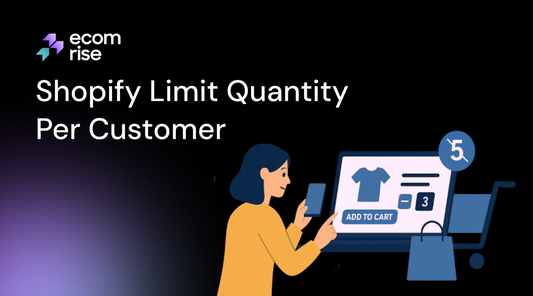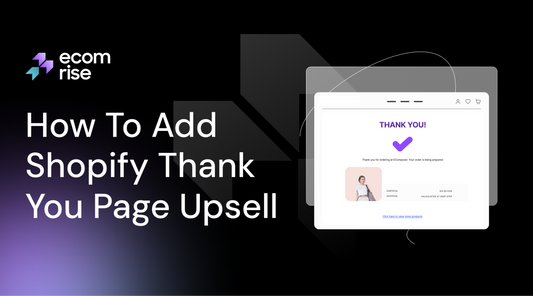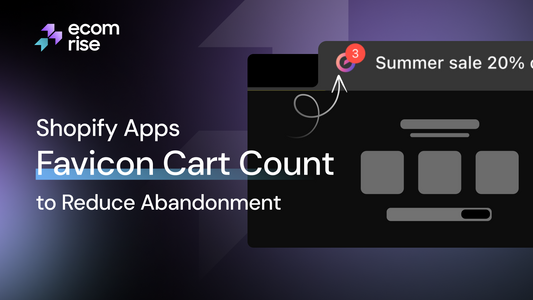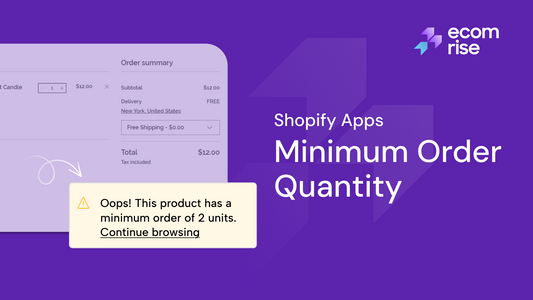How To Add Trust Badges To Shopify Store
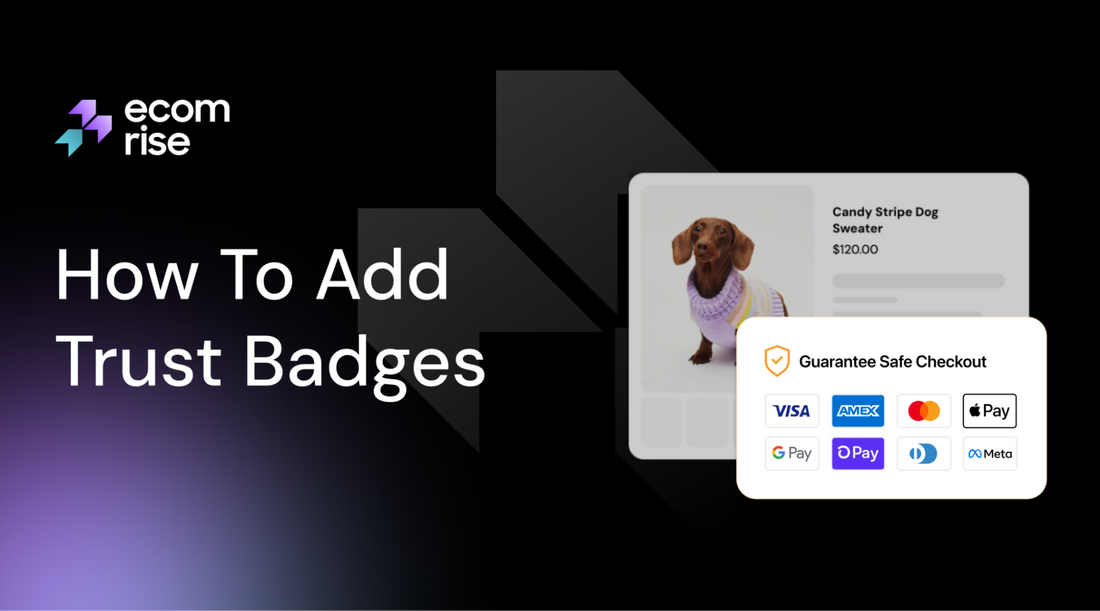
When customers visit your Shopify store, they need to feel confident that their information is safe and that their purchases will be handled with care. This is where trust badges come in. These small yet mighty icons can make a huge difference in how customers perceive your store’s reliability.
In this blog, we'll walk you through what trust badges are, why they're important, and how to add trust badges to your Shopify store easily—so you can build trust and see sales grow!
What Is A Trusted Badge?
A trust badge is a symbol or emblem displayed on your website to assure customers that they’re shopping on a legitimate, secure platform. These badges are visual cues that show shoppers their personal information and payment details, which will be handled with care by your store and its trusted third-party partners. From security seals to product authenticity markers, trust badges play a vital role in establishing your store’s credibility.
For emerging retailers who may not yet have the brand recognition of industry giants like Amazon or Walmart, trust badges are essential. They act as a digital handshake, reassuring potential customers that your site is safe and reliable. These badges serve as a visual cue that you can be trusted with sensitive data and that your products and services are legitimate.
Trust badges come in different forms, each offering unique reassurances, but they all have one goal: to make consumers feel confident about their purchases.
The Benefits of Trust Badges for Your Shopify Store
Trust badges are more than just eye-catching symbols—they’re a powerful tool for building credibility and boosting sales. While adding trust badges to your Shopify store does require some effort, the benefits are well worth it. Here are three key reasons why you should consider adding them to your site:
1. Build Shopper Confidence
As online shopping becomes more popular, so does the risk of fraud. With this in mind, consumers have grown more cautious when shopping online, making it essential to establish trust. Trust badges, such as SSL certificates and money-back guarantee seals, signal to customers that your store is safe and reliable.
2. Boost Conversion Rates
Trust badges can have a significant impact on your conversion rates. By alleviating concerns and providing visual reassurance, these badges help reduce the anxiety shoppers may feel about completing a purchase. When customers trust that their information is safe and that they’re dealing with a reputable store, they’re more likely to follow through with their purchase.
3. Lower Cart Abandonment
Cart abandonment is a common problem for many online retailers, and often, it’s caused by customers feeling uneasy about the security of their transactions. Trust badges, particularly on the checkout page, can help reduce this hesitation. This lowers the perceived risks of completing a purchase, helping to decrease cart abandonment and increase your overall sales.
5 Types of Trust Badges for Your Shopify Store
Type 1: Safe Checkout Badges

Safe checkout badges indicate that your store’s checkout process is secure, which is crucial in building trust with customers. One of the most trusted badges in this category is the Norton seal, which is seen by millions of users worldwide. In fact, research shows that nine out of ten customers are likely to continue their purchase after seeing this seal during checkout. Other popular safe checkout badges include the PayPal seal and TRUSTe, all of which assure customers their sensitive data is protected throughout the transaction.
Type 2: Accepted Payment Badges

Customers are often hesitant to share their credit card information online due to security concerns. To alleviate these worries, display accepted payment badges like Visa Secure and American Express SafeKey on your checkout pages. Studies by the Baymard Institute show that 19% of cart abandonments happen because customers don’t trust the website with their payment details, and a further 9% are due to insufficient payment options. By showcasing trusted payment methods, you can reduce these concerns and encourage customers to complete their purchases.
Type 3: Third-Party Endorsements

A third-party endorsement is like a stamp of approval from an authoritative source. Adding these badges to your Shopify store lets customers know that a trusted organization has vetted your business. Examples include Better Business Bureau (BBB) accreditations, client logos, professional body recommendations, industry awards, and media placements. These badges are handy for stores with unique products or complex business models. For instance, the fashion subscription service SprezzaBox showcases media logos to reassure customers about its legitimacy.
Type 4: Free Shipping and Returns Badges

Offering free shipping and returns is a great way to increase conversions, as shoppers love the idea of no additional costs or hassles when it comes to returns. According to Retention Science, conversion rates for free shipping offers are twice as high as those for “percentage-off” discounts. Adding free shipping and returns badges to your website can make a significant difference. For example, furniture brand Burrow prominently features a “free & fast shipping” badge on its homepage, encouraging customers to take the next step.
Type 5: Money-Back Guarantee Trust Badges

Money-back guarantee badges assure customers that if they aren’t satisfied with their purchase, they can receive a full refund within a specified period. These badges are particularly effective for high-ticket items like electronics, appliances, and furniture, as they reduce the perceived risk for buyers. Brands like Casper use money-back guarantee badges to promote their 100-night risk-free trial, making it easier for customers to trust their purchase decision.
How To Add Trust Badges to Shopify Store Using EcomRise
EcomRise simplifies the process of adding trust badges to your Shopify store, offering a user-friendly setup and customization options to enhance customer confidence. Here’s how you can leverage EcomRise’s Trust Badge feature:
Step 1: Access EcomRise in Your Shopify Store
- Navigate to your Shopify admin panel and open the EcomRise app.
- From the dashboard, select Extra Extensions and locate the Trust Badge feature.

Step 2: Install the Trust Badge Extension
- Click on the Install Extension button to add the Trust Badge functionality to your store.
- Once installed, the trust badge section will automatically appear on your product pages.

Step 3: Customize Your Trust Badges
EcomRise offers extensive customization options to ensure the trust badges align with your store's branding:
- Positioning: Drag and drop the trust badge section to your desired location on the product page.
- Title and Font: Adjust the badge title and font size for better visibility.
- Badge Type: Choose between two options: Store Payment Method, Custom Badges

- Custom Options: Image Upload, SVG Customization (e.g., remove PayPal if not supported).

Step 4: Upgrade for Premium Features
Upgrade to the Premium Plan to unlock additional customization options and enhanced Trust Badge functionalities.
Uninstall Option
- If needed, the Trust Badge extension can be removed easily through the app’s settings.
- Note: The Trust Badge feature is currently limited to product pages, making it an ideal tool to reassure customers directly at the decision-making stage.
Common Trust Badge Placements in Shopify Stores
1. Product Pages

Placing trust badges on product pages is a highly effective strategy to reassure customers about your store’s credibility at the point of decision-making. These badges can highlight secure payments, money-back guarantees, or authenticity assurances.
|
Pros |
Cons |
|
2. Cart Pages

Trust badges on the cart page serve as a final reassurance to customers before they proceed to checkout. This placement is particularly effective in reducing cart abandonment rates.
|
Pros |
Cons |
|
|
3. Checkout Pages

The checkout page is the last opportunity to reassure customers about the safety of their payment details. Trust badges here focus on secure transactions and data protection.
|
Pros |
Cons |
|
|
4. Footer

Adding trust badges to the footer ensures their visibility across all pages of your Shopify store, providing continuous reassurance to customers during their browsing experience.
|
Pros |
Cons |
|
|
5 Common Mistakes to Avoid When Adding Trust Badges

While trust badges can significantly enhance the credibility of your Shopify store, using them incorrectly can have the opposite effect. To help you get the most out of your trust badges, here are five common mistakes to avoid:
Overloading with Trust Badges
It’s tempting to show off all the security seals, payment guarantees, and endorsements you can find, but too many trust badges can overwhelm your customers and make your website look cluttered. Visual overload can confuse rather than reassure, detracting from the clarity of your message.
Using Low-Quality Images for Badges
Trust badges are meant to reassure customers, but if they look blurry, pixelated, or poorly designed, they can have the opposite effect. Low-quality badges make your website look unprofessional and can even raise doubts about your security practices. Always use high-resolution, professionally designed images for your trust badges to maintain a polished and trustworthy impression. This attention to detail helps customers feel confident in your store and its commitment to security.
Ignoring Mobile Optimization for Trust Badges
With the rise of mobile shopping, it’s crucial to ensure your trust badges are optimized for all devices. Badges that look perfect on a desktop may become distorted, too small, or difficult to read on smartphones and tablets.
Using Outdated Trust Badges
Using outdated or irrelevant trust badges can signal to customers that your site isn’t up to date with current security standards. It’s essential to regularly review and refresh your trust badges to reflect the latest certifications, security protocols, and industry standards. Keeping your badges current shows customers that you are actively maintaining a secure environment, which strengthens trust and credibility in your store.
Displaying Unverified Badges
One of the most damaging mistakes you can make is displaying trust badges that aren’t backed by verified organizations or certifications. Unverified badges can mislead customers and erode trust in your store. Always ensure that the badges you display are genuine and verifiable. Misrepresenting your security claims can lead to legal issues and a loss of customer confidence.
Frequently Asked Questions
1. Where do you put Trust Badges?
Trust badges should be strategically placed in prominent positions throughout your Shopify store to maximize their impact on customer confidence and conversion rates. Key locations include:
- Product Pages: To reassure customers about security and authenticity while they browse.
- Cart Pages: To reduce cart abandonment by reinforcing trust during the purchase process.
- Checkout Pages: To provide a final layer of assurance before customers complete their payment.
- Website Footer: Ideal for displaying payment method badges to establish credibility across all pages.
- Homepage and Key Category Pages: Many stores add free shipping badges and third-party endorsements here to highlight benefits and build trust from the start of the customer journey.
Strategically placing trust badges ensures that they’re visible at critical decision-making points, helping to create a seamless and trustworthy shopping experience.
2. Are trust badges important?
Yes, trust badges are highly important for your Shopify store. They play a crucial role in reassuring customers about the security and reliability of your business. By fostering trust, these badges can:
- Increase Conversion Rates: Trust badges help convince customers to proceed with their purchases.
- Reduce Cart Abandonment: By alleviating doubts at checkout, they lower the chances of customers leaving without completing their orders.
Trust badges are an essential tool for building credibility and creating a seamless shopping experience that encourages customer loyalty and higher sales.
3. How do I insert a badge in Shopify?
To insert badges in Shopify:
- Use Theme Editor: Find the "Product Blocks" or "Featured Products" section and add badges.
- Use a Third-Party App: Install apps like "Product Badges" or "Booster" for easy badge creation.
- Edit Theme Code (Advanced): Add HTML code to the product template file.
Choose the method that best suits your technical skills.
4. How to add a verified merchant seal to Shopify?
To add a verified merchant seal (like Authorize.Net) to your Shopify store:
- Get the Seal: Obtain the seal code from your payment processor.
- Add to Theme:
- Use the Theme Editor to add the code to your footer or checkout page.
- Or, edit the theme code directly (advanced).
- Display Prominently: Place the seal where customers can easily see it.
This builds trust and increases conversions.
5. Can I create custom trust badges to match my store’s branding?
Yes, many apps allow you to upload custom badge designs or modify existing ones. For example, with EcomRise, you can upload custom images or SVG files to create unique trust badges tailored to your brand.
6. Which Shopify apps are best for adding and customizing trust badges?
Popular Shopify apps for trust badges include EcomRise, EComposer, and Ultimate Trust Badges. These apps provide pre-designed templates and customization options for seamless integration.
7. Can I add trust badges to multiple sections of my Shopify store?
Yes, trust badges can be added to various sections, including product pages, the cart page, the checkout page, and the footer, depending on your store's theme and the app you're using.
8. What are trust badges, and why are they important for a Shopify store?
Trust badges are visual indicators (such as payment icons or security seals) used to reassure customers of your store's credibility and security. They help increase customer confidence, reduce cart abandonment, and boost conversion rates.
Final Thoughts
Adding trust badges to your Shopify store isn’t just a nice-to-have; it’s a must-have. These small visual elements carry immense power to reassure your customers, boost conversion rates, and reduce cart abandonment. So don’t wait—start adding trust badges today and watch your sales soar!
If you have any questions or need further assistance, feel free to drop a comment or explore our EcomRise app. Your journey to building a trusted Shopify store begins now!





